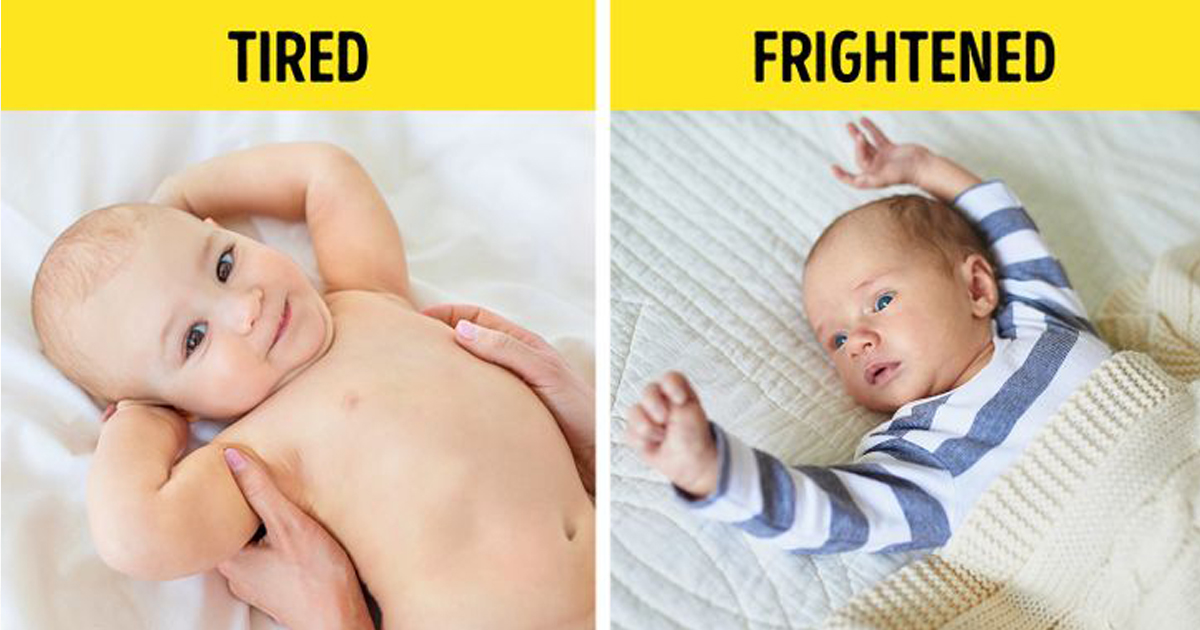What do the biz arre head ban ging and the adorable eye rubbing mean? Why is your baby suddenly acting cold by turning their face away, or sometimes kicking in the air like the next Karate Kid?
It would be great to have a heads up when your baby is about to bawl or when they want more attention. You might not always be able to understand exactly what they want and respond accordingly, but there are some telltale signs that most babies have. In the specifics of this article, we will discuss signs that babies make and what they really mean.
It’s decoding time!
Body Movement
Understanding body movements can greatly help understand what your baby is trying to tell you without actually being able to put their emotions into the dialog.
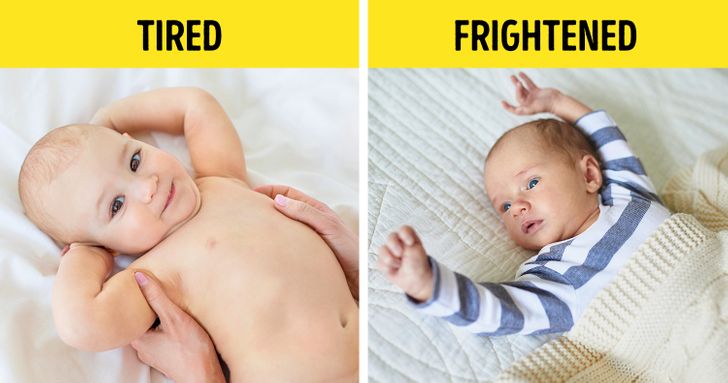
Source: BrightSide
Arching back: An arching back in a baby could indicate satiety, heartburn, colic, or GI reflux. Your baby’s stomach sphincters are still growing, which means they are vulnerable to acid reflux. Babies arch their backs trying to stretch their stomachs, in an attempt to avoid further discomfort.
If you notice your baby arching their back during the feeding-time, try comforting them, and pause feeding them for a while. It is ideal to distract them and rub their backs to calm the reflux. If the baby is arching their back more often than they should, and it persists, consult a pediatrician.
Ear-grabbing: Ear-grabbing is subjective. For instance, if the baby is ear-grabbing when in fever or suffering from a cold, it could be due to an ear infection.
On a regular note, ear-grabbing in babies is their way of reacting to the discovery of their ear (which they are probably considering to be a foreign object) or a reaction to teething.
If the baby is ear-grabbing owing to teething, now is the time to get them teething toys, On the other hand, if you suspect an ear infection, consult a pediatrician.
Head-ban ging: The rhythmic movement of the head back and forth, in infants and babies, is termed head-ba nging. Usually, it is a self-soothing technique. Babies do it mostly when they are sleepy, or right before their nap.
You do not need to fret about this, since this self-comforting gesture wears out by the age of three, without any compulsion. Keep in mind to protect the baby, however, so they do not hit a hard surface and in jure themselves. To prevent inj uries, use permanent padding on the edges of the cradle walls or temporary ones before your baby’s ‘dreamland-time’.
Constant kicking: “I am happy and content. It was the milk, mommy!”, that is what most babies mean when they are kicking (at least generally). Happy and content kicking also helps your baby develop his/her leg muscles and is a prerequisite to rolling.
But, not all kicks are happy and content. If your baby is kicking too much, after being overfed, and looks bloated, they are probably kicking in an attempt to burp out. Help them burp out and check the mother’s diet to analyze what caused the gassiness in the baby while being bre astfed.
Grumpiness: An unsettled and grumpy body language in the baby could depict overstimulation. If the baby has recently been feeling unsettled after a large family gathering or something similar, that could be what is making the baby grumpy.
Isolate the baby, rocking and soothing them; avoid any sort of social contact until they are calm. Is your baby a fan of soft indie music? Put it on and give them their yearned ‘private time to go back to being happy and giggly.
Fist clenching: Babies have a primitive reflex known as palmar grasp. Fist clenching is a consequence of this reflex in babies. This usually disappears between 5-6 months of age and may be very recurring in newborn babies as a result of natural instincts, much of a continuation from how babies frequently clenched their fists inside the womb of the mother.
Although it is a natural instinct, fist-clenching could also be a sign of hunger or stress in babies. If they are continuously fist-clenching, it is time to feed them, or maybe soothe them with a lullaby, if they are already full.
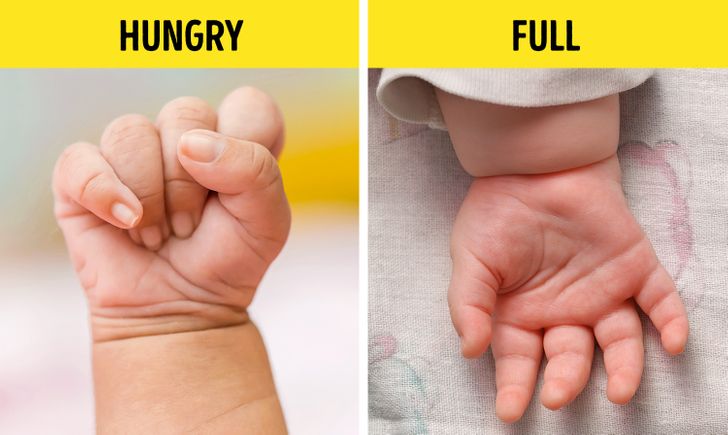
Source: BrightSide
Baby hiccups: Baby hiccups are often a sign of overfeeding or quick feeding. These baby hiccups are common in babies under the age of one and usually subside within 5-10 minutes.
Besides, if you are not in the habit of burping out your baby, you are most likely to find them hiccuping after a meal or feed. To avoid aggressive hiccuping after feeding your baby, burp them out, or try changing their breastfeeding position; try avoiding improper latching during breastfeeding as well.
Arm jer ks: Arm j erks are a reaction to a disturbance in sleeping by a bright light or loud sounds. Babies je rk their arms when they are startled. More of an involuntary movement, arm jer ks are also termed as Moro reflex. Babies eventually stop j erking out their arms with age, and since it is only a reflex there is nothing to stress over the same.
To avoid startling your baby (and hence the arm jer king), maintain a comfortable and quiet sleeping environment for your little one.
Eye-rubbing: Eye rubbing simply translates to “I am ready to visit the dreamland ” cue. Babies usually rub their eyes when they are sleepy and tired. Most of the time, they also simultaneously yawn and start drooping their eyelids.
However, if the baby has a tint of red in their eyes or a visible foreign particle, chances are the baby is rubbing their eye out of irritation. If the eye-rubbing is consistent, or you are suspecting of a foreign particle in the baby’s eye, consult a pediatrician for any infections.
Breathing quickly: Is your baby maintaining a happy face while breathing quickly? That is because they can not contain their excitement – they are just happy! If quick breathing is a result of happiness in the baby, the breathing rate will soon return back to normal, and if it does not, immediately consult a doctor.
Your baby could also be breathing quickly because they are startled. If that’s the case, divert their attention, talk to them, or comfort them.
Scrunching the knees: Scrunching the knees is similar to arching back, as both of them are cues to the baby feeling gassy or constipated. Babies often tend to bring their knees to the abdomen to ease the feeling of discomfort owing to constipation or gassiness.
Massaging the baby’s tummy in a clockwise direction or burping them out can help against the discomfort that comes from gassiness or constipation. In the meantime, also try to eliminate any gas-inducing foods in the meal of the mother, if the baby is being breastfed.
Turning the face away: Turning the face away translates to the “I am bored and so done” cue. If your baby is bored or upset, or even being force-fed, they could turn away their face while you are still interacting with them.
If your baby is under six months, or in a foreign place they have not been before, they could be turning their heads a lot, absorbing and reading their surroundings.
As mentioned, if the baby has a full tummy and zero remaining appetite, and is still being force-fed, they are most likely to turn their face away. Won’t we all?
Suc king fingers: Su cking fingers is a natural instinct in babies to replicate the feeling of being br eastfed or bottle-fed. Since the baby’s natural su cking reflex helps them latch onto the breast or bottle nipple, suc king fingers, usually the thumb, could be an indication that they are hungry.
When you notice the baby suc king their digit even when they are full, it could be a way to soothe themselves. In this case, try offering your baby a pacifier to provide them with a better alternative to the self-soothing technique.
Baby grimacing, grunting, and bearing down: This is one body language that almost every parent could recognize – the pooping! Babies grimace, grunt, and bear down when they are pooping. If the grimace or grunting is stronger than usual, the baby could be constipated.
To make the whole defecation process smoother, try relaxing your baby and rub their bellies gently. To help a constipated baby, try cycling of legs to stimulate the intestines. If the grimacing and grunting are persistent, consult your doctor.
Stretching Out Arms: Stretching out arms with open hands and fingers is a good sign – your little munchkin is happy and delighted. If your baby has recently acquired the skill of sitting, stretching out arms could be an attempt to balance themselves while trying to sit up straight.
When the outstretched arms are an attempt of balancing their posture, you can ‘extend a limb’ and help your baby while they try to sit. Instead of actively making them sit, the idea is to help them. You can also surround the baby with soft pillows or cushions, so they do not lose balance and hurt themselves in the process.
Crying
One thing about babies is that they ‘can’ cry A LOT. Sometimes it can be baffling when you have racked your brain for every solution in an attempt to comfort them but nothing seems to work. This is why it is important to understand what the crying cues of your baby really mean.
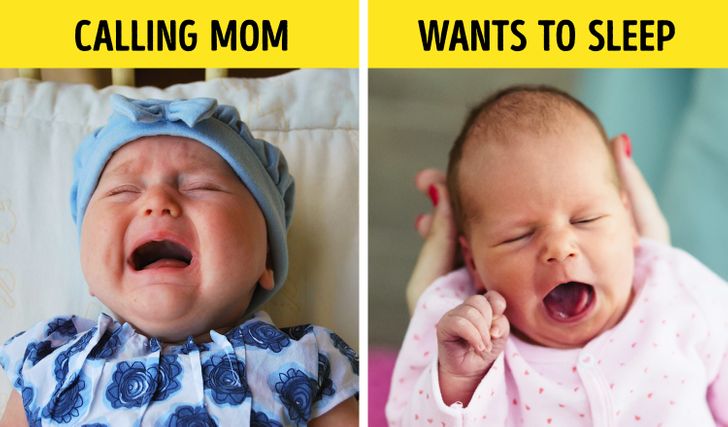
Source: BrightSide
5 Sounds Your Infant Makes Before They Cry
Here is how a baby’s signs can be identified by the sounds that they make before they are about to cry and the way they cry.
“Neh”- I’m hungry! When your infant makes the sound ‘neh’ they are trying to indicate that they are hungry. This sound is produced as a reflex when your baby starts suckling and their tongue touches the roof of their mouths as a result. Other signs that accompany this sound include their attempt to chew their little hands or suck on their thumbs. They might also inch towards your breast region and cry rhythmically.
“Owh”- I’m sleepy: Their little ‘owh’ sounds like a little person yawn which is exactly what it is. This sound means that they are tired and would love to take a nap now. You will see them rub their eyes and they start crying, slowly at first before raising the pitch and intensity. It is easily confused with their cry when they are hungry and the pre-cry signs help you distinguish between the two.
“Heh”- This is uncomfortable! : They might need a nappy change or they are just itchy, wet, and/or hot or cold. Whenever they’re uncomfortable your infant might just say heh to indicate their discomfort. Their cry won’t be a screeching one- it will mostly be mild with pauses but it won’t be long before they start screaming so quick attention is key.
“Eh”- I need to Burrrrrp! : Your baby might have an air bubble trapped in their chest that they are unable to release and need your help with. Them saying eh is their way of trying to get rid of the air bubble that is trapped and they will appear to physically struggle and turn their face away if you try to feed them.
“Eairh”- Baby Fart Incoming: An upset tummy or a burp that has traveled into the stomach causes this sound reflex and the intestine gets to work to push the bubble out. This could also mean that they are about to make a poo and the accompanying cry will be shrill and intense. You can observe their body movements as they bend their knees to ease the bowel movement.
Identifying different types of baby cries:
Below is an elaboration on how babies cry when they are in the following situations:
I’m hungry: When your little munchkin is hungry, their cry is a low-pitched, repetitive and rhythmic cry. This is usually in combination with other signals that imply hunger such as body movements (as discussed above), a sucking motion of the tongue, rooting for the breast when in someone’s lap, and sucking their digit.
Always respond to hunger cues almost immediately, before the cues transition into full-fledged crying.
I’m tired or uncomfortable: When your baby wants their much-needed nap-time, and nobody has paid enough attention to rock them to sleep or comfort them, they will most likely start crying. The sound is whiny, nasal, and a continuous cry that slowly builds in intensity.
The solution is to rock your baby to sleep if the crying is accompanied by yawns, drooping eyelids, and eye-rubs. If the crying is consequential to discomfort, check for the cause of their discomfort (possibly a dirty diaper, or an uncomfortable position in the car seat).
I’ve had enough: Combine turning away the face with a fussy and whiny cry – that is the peak of your baby’s frustration. This cry is easily identifiable by the baby’s movements.
To relax your baby, try moving them away from any sort of noise or visual stimulation, or anything that is stressing her out. Isolate her from any active gatherings and try playing some soft music or nature sounds.
I’m bored: The ‘I’m bored’ cry initially starts as a coo that is an indication that your baby is trying to get a good interaction going. When the baby is unable to establish that interaction, the cooing transitions into fussing, which in the next stage bursts into an indignant crying, occasionally altered with whimpers.
If your baby is cooing to get your attention and play with you, be at their beck and call and play with them before hell unleashes on earth.
I’ve got colic: Fidgeting movements that are accompanied by intense wailing and creaming usually denote the baby has gotten colin. Since colic often occurs in the late afternoon or in the evening, intense wailing or crying during this timeframe is a strong indication that your baby has got colic.
Colic is common in infants over 6 weeks of age, and usually goes away around the age of 3-4 months.
I’m sick: Sick babies are unable to pump up the volume to cry when they are sick. Thus, when you are listening to soft whimpers that are weak and nasal-sounding with a lower pitch in comparison to the crying they do when they are tired, they are most likely sick.
Look for additional symptoms such as constipation, vomiting, rashes, and most importantly fever, and if the baby shows any of these symptoms, call the doctor immediately.
Baby Sounds
Apart from crying and body movements, there are sounds that babies make to convey certain emotions.
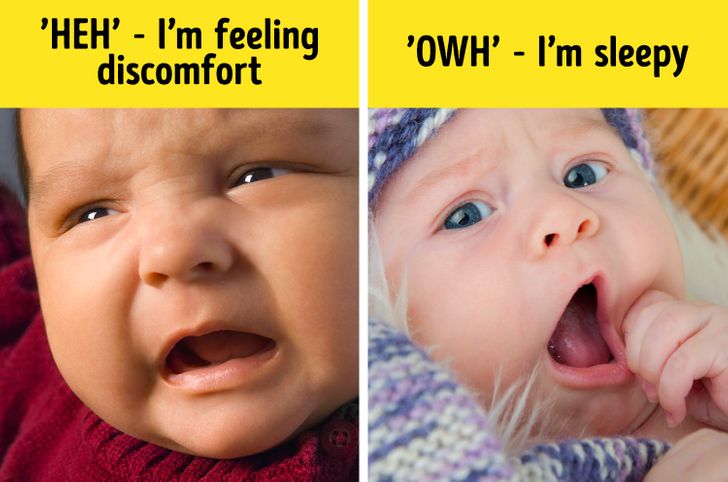
Source: BrightSide
Here is all about them:
Sighs: This is a delightful sound to hear from your infant and they start sighing when they are just weeks old. Whenever they are content and everything feels good, they sigh to indicate that they are relaxed. It also helps them relax further.
Squeals: This can be confusing- it could mean that they’re excited and happy or that they’re positively distressed. If it is during a game or when you are actively engaging them, it is a sign of delight and enthusiasm. Otherwise, if it is persistent, make sure everything is okay.
Chuckles: When they are about 4-5 months old, your baby will delight you with a little chuckle that will make your day. They might start by responding to your physical stimulation of them such as when you tickle them. But eventually, they start to develop a sense of humor and well, laugh at you when you do amusing things.
Panting: This is quite scary, and new parents freak out whenever their young infants start panting for 10-12 seconds at a time. Unless this is persistent or leads to any sort of discoloration, you don’t need to worry. Your little one is just learning how to breathe through their mouth. Maybe there’s a booger stuck up their nose and you might have to get it out of there for them.
Babbles: Oh, the baby babbles. We love to hear it and we desperately wish we understood it. This starts around the age of 4-6 months and they go on to speak a language of their own. Sometimes, it sounds like there are a few proper words in there as well. Slowly, they’ll pick up words and phrases and start to comprehend what everything means.

